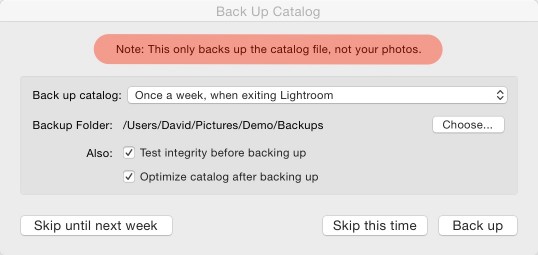![]() As a photographer, protecting your photographs is vitally important. In this post, we’ll explore some of the most popular backup methods and provide tips on how to ensure that your backups are successful.
As a photographer, protecting your photographs is vitally important. In this post, we’ll explore some of the most popular backup methods and provide tips on how to ensure that your backups are successful.
Adobe Photoshop Lightroom is a wonderful program but it is not an image backup system. Your Adobe Photoshop Lightroom Classic Catalog, and all of your digital photos, are at constant risk due to software malfunctions, computer crashes, hard drive failures, and natural disasters.
Losing any of your precious files due to unforeseen circumstances can be financially and emotionally devastating. The question that you should be asking yourself is not “will my computer eventually fail” but rather “what steps can I take right now so that I am well prepared when a disaster inevitably occurs?”
Lightroom Classic Backup Myths
Many novice Adobe Photoshop Lightroom Classic users are lulled into thinking that their images are safely protected by three misleading features inside of this program.
First, many people are confused about what Classic’s Catalog Backup really accomplishes. This “Catalog Backup” feature creates a duplicate copy of your Lightroom Catalog file only and it provides absolutely NO protection for your precious images. This feature will not help you at all if your images are lost, deleted, or destroyed.

Some Lightroom Classic users are also fooled by the Make A Second Copy To: feature that exists inside of Classic’s Import Dialog. When enabled, this option will make you a second copy of your images as they are added into your Lightroom Catalog and it will store these files away for you in a separate folder.
The problem here is that after that Import session ends that Lightroom Classic never updates these “second copies” with any additional information. Classic will never update these copies as the days and weeks go by. If you had to resort to using these Import Backups after a disaster then you can look forward to removing every dust spot, adding every keyword, and doing every bit of work that you have lost all over again.
Finally some users confuse Adobe’s marketing terms–words like the Adobe Creative Cloud, Smart Previews, or Lightroom Mobile App Synchronization— with some type of automatic online backup system. Sadly, none of these Lightroom Classic features do anything that like that and none of them will protect your Catalog or all of your precious images.
Don’t be fooled! If you are an Adobe Photoshop Lightroom Classic user then it is your responsibility to build your own backup system.
Backblaze: An Inexpensive Online Backup Solution
Backblaze is an inexpensive cloud-based backup service that offers unlimited storage and unlimited file sizes. For less than $10 per month, anyone with a high-speed internet connection can use the Backblaze Personal Backup service to protect their images, their Lightroom Classic Catalog, and all of the other important files on their computer.
Backblaze is easy to install and it can run silently in the background continually uploading all of your precious data to their secure servers. As long as you have a solid internet connection then there is no easier way to protect everything that matters than with this kind of online data storage.
If you decide that Backblaze suits your needs then be sure that you read their Best Practices Guide and pay careful attention to their Version History policy if you need to protect images that live on external hard drives.
Backing Everything Up With Your Own External Hard Drives
You can also create your own robust backup system using a pair of inexpensive external hard drives and a dedicated backup utility program. Once you have acquired, and properly formatted, a pair of external hard drives then you can use a backup utility like Apple’s Time Machine program or Carbon Copy Cloner to protect your images. Programs like these will automatically copy everything that matters from your computer over to an external hard drives for you on a regular basis.
The video tutorials below will teach you how to create a reliable backup for Lightroom Classic and all of your images. In the first video tutorial below, I will teach you how to configure Apple’s integrated Time Machine utility so that it will backup your entire computer, and all of your photographs, to an external hard drive.
Although Time Machine is the easiest way to backup a Mac, this program offers little flexibility. The video below will teach you how to build a more precise method using the Carbon Copy Cloner backup utility from Bombich Software. Carbon Copy Cloner backups are a better choice for busy professional photographers and for those with more complex backup needs.
Finally in the video below, my friend Forest Chaput from the Rocky Mountain School of Photography demonstrates how Windows users can build a reliable backup system using the SyncBack Backup utility.
On-Site & Off-Site Backups
At this point, you might be wondering why I keep suggesting a pair of external hard drives for your backups. The logic here is that keeping all of your hard drives in one place puts everything at risk. On-site backups, meaning backup drives that are stored in your home or office, are useful when there are small hiccups like a hard drive failure. On-site backups are important but off-site backups offer more protection if you encounter catastrophic events like a hurricane, a house fire, or a lightning strike.
If you are using an online backup service like Backblaze.com then you have already have an off-site backup. If you are not using a cloud backup service then it is a good idea to store one of your backup hard drives outside of your home or office. As long as you rotate between your external backup disks on a regular basis then you can maintain your own on-site and off-site backup system without the expense, and internet drain, that a cloud-based system requires. This is why I strongly suggest using two separate drives, or on on-site drive and a cloud backup service like Backblaze, to protect your images.
By alternating which external backup drive I have inside of my house each week, I am significantly increasing the odds that all of my photos, and my Lightroom Catalog, will survive a significant catastrophic event.
Conclusion
If paying for an additional online backup service like Backblaze.com, and / or building your own backup system using a pair of external hard drives, seems like a lot of effort then consider the dismal alternatives. What would you lose if your computer died right now and none of your files could be recovered?
If the answer to this question is that “you could lose everything” then you need to take immediate steps to improve your backup system!
Affiliate Disclosure: Some of the links on this site are affiliate links, meaning that I may earn a commission if you click on them and make a purchase. This commission comes at no additional cost to you and I only recommend products or services that I use and believe in.
